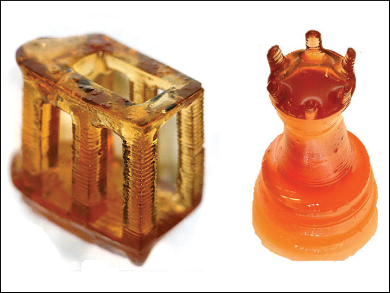High-performance thermoplastics with all-aromatic structures can have degradation temperatures of over 500 °C and good mechanical stability. However, they also have high glass transition temperatures (over 200 °C), which makes them difficult to process and shape.
The polyimide Kapton is an example for this type of polymer. It is based on pyromellitic dianhydride and 4,4′-oxydianiline (PMDA–ODA). The material is commonly available in film form and can be used, e.g., in aerospace applications such as satellites. Complex shapes, however, are tough to manufacture with the current energy-intensive molding technologies.
Timothy E. Long, Virginia Tech, Blacksburg, VA, USA, and colleagues have developed a 3D printing process that allows the generation of complex and detailed shapes from PMDA-ODA. The team used a soluble poly(amic ester) with acrylate groups to create a precursor polymer solution. The acrylate groups can be crosslinked using light and an added photoinitiator. Custom 3D printers were used to photopolymerize the material in the desired shapes (examples pictured). The solvent was then removed and the material imidized at up to 350 °C to create the PMDA-ODA polymer. The samples shrink isometrically during this process while retaining the printed shape.
According to the researchers, this processing technique could be useful to design PDMA-ODA structures with lower weight or improved functionality for aerospace applications. It could also allow the creation of complex structures from other all-aromatic polymers.
- 3D Printing All-Aromatic Polyimides using Mask-Projection Stereolithography: Processing the Nonprocessable,
Maruti Hegde, Viswanath Meenakshisundaram, Nicholas Chartrain, Susheel Sekhar, Danesh Tafti, Christopher B. Williams, Timothy E. Long,
Adv. Mater. 2017.
DOI: 10.1002/adma.201701240



